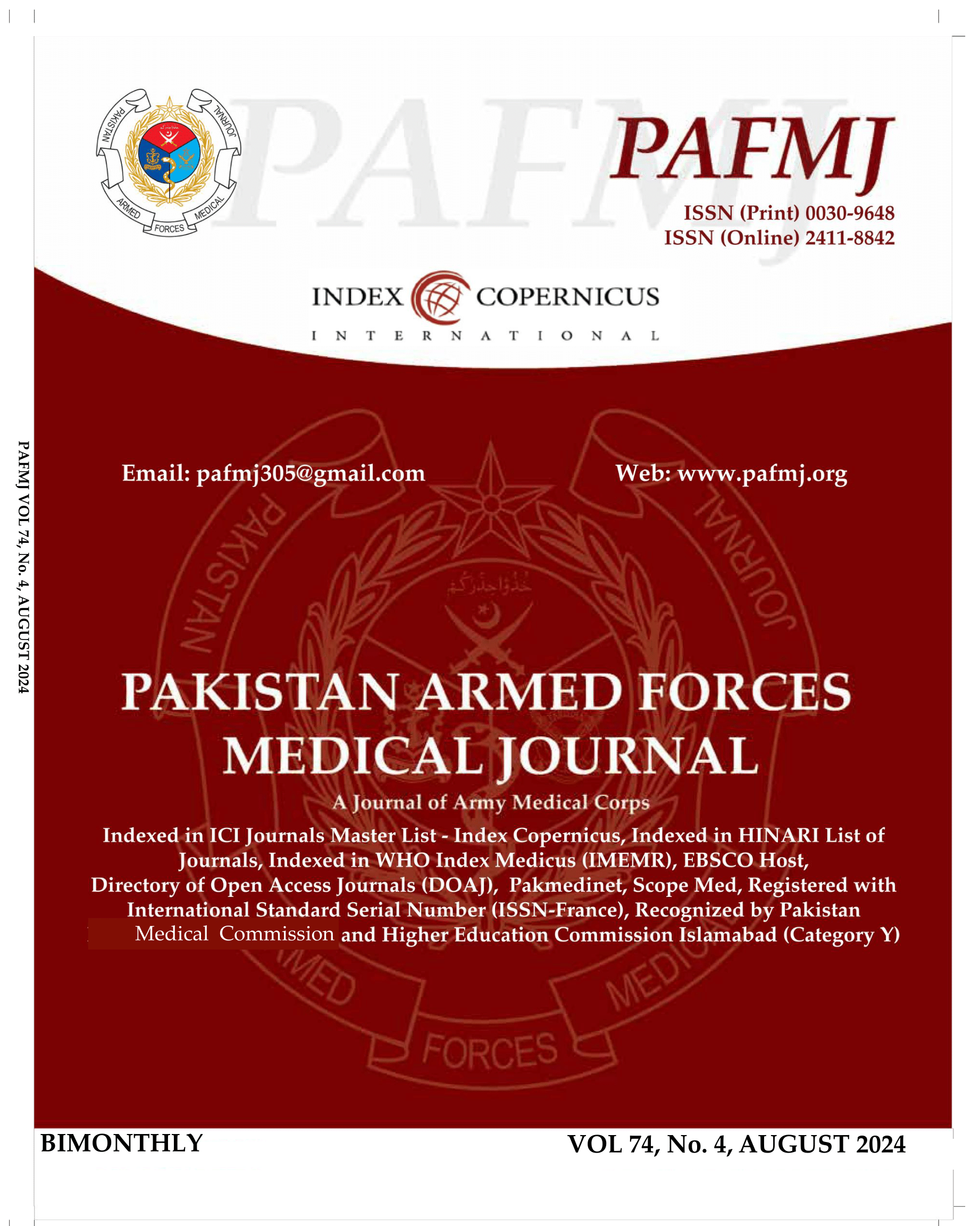Comparison of Intravenous Lignocaine and Intravenous Dexmedetomidine for Attenuation of Hemodynamic Stress Response to Laryngoscopy and Endotracheal Intubation
DOI:
https://doi.org/10.51253/pafmj.v74i4.7000Keywords:
Dexmedetomidine, Intubation, Laryngoscopy, LignocaineAbstract
Objective: To compare the efficacy of Lignocaine and Dexmedetomidine in minimizing the hemodynamic stress response associated with laryngoscopy and endotracheal intubation.
Study Design: quasi-experimental study.
Place and Duration of Study: Department of Anesthesiology, Combined Military Hospital Rawalpindi, Pakistan, from Jul 2020 to Feb 2021.
Methodology: A total of 60 patients, aged 18-55 years were included in this study. They were randomly allocated to one of two groups. Group-L received intravenous Lignocaine, 1.5 mg/kg. Group-D received Dexmedetomidine 1 µg/kg as intravenous infusion 10 minutes before induction. Heart rate and mean arterial pressure were monitored at basal, pre-induction, induction, laryngoscopy and intubation and 1, 3, 5 and 10 minutes afterwards.
Results: Significantly reduced stress response was seen in Group-D as compared to Group-L. A lesser increase in heart rate was observed during intubation as compared to basal level in Group-D (14.14%) while it was 37.66% in Group-L. MAP was also seen to be less increased in Group-D (1.07 %) as compared to Group-L (22.6%).
Conclusion: Dexmedetomidine, when infused at a dose of 1 mcg/kg over 10 min prior to intubation, attenuates the hemodynamic stress response more efficiently, in comparison to 1.5 mg/kg of Lignocaine infusion.
Downloads
References
Barak M, Ziser A, Greenberg A, Lischinsky S, Rosenberg B. Hemodynamic and catecholamine response to tracheal intubation: direct laryngoscopy compared with fiberoptic intubation. J Clin Anesth 2003; 15(2): 132-136.
doi: https://doi.org/10.1016/s0952-8180(02)00514-7
Figueredo E, Garcia‐Fuentes EM. Assessment of the efficacy of esmolol on the haemodynamic changes induced by laryngoscopy and tracheal intubation: a meta‐analysis. Acta Anaesthesiol Scand 2001; 45(8): 1011-1022.
https://doi.org/10.1034/j.1399-6576.2001.450815.x
Srivastava VK, Agrawal S, Gautam SK, Ahmed M, Sharma S, Kumar R. Comparative evaluation of esmolol and Dexmedetomidine for attenuation of sympathomimetic response to laryngoscopy and intubation in neurosurgical patients. J Anaesthesiol Clin Pharmacol 2015; 31(2): 186-190.
https://doi.org/10.4103/0970-9185.155146
Barak M, Yoav L, Abu el-Naaj I. Hypotensive anesthesia versus normotensive anesthesia during major maxillofacial surgery: a review of the literature. Sci World J 2015; 2015: 480728. https://doi.org/10.1155/2015/480728
Giovannitti JA Jr, Thoms SM, Crawford JJ. Alpha-2 adrenergic receptor agonists: a review of current clinical applications. Anesth Prog 2015; 62(1): 31-39.
https://doi.org/10.2344/0003-3006-62.1.31
Miller CD, Warren SJ. IV Lignocaine fails to attenuate the cardiovascular response to laryngoscopy and tracheal intubation. Br J Anaesth 1990; 65(2): 216-219.
https://doi.org/10.1093/bja/65.2.216
Wilson IG, Meiklejohn BH, Smith G. Intravenous Lignocaine and sympathoadrenal responses to laryngoscopy and intubation. The effect of varying time of injection. Anaesthesia 1991; 46(3): 177-180.
https://doi.org/10.1111/j.1365-2044.1991.tb09403.x
Menda F, Köner O, Sayin M, Türe H, Imer P, Aykaç B. Dexmedetomidine as an adjunct to anesthetic induction to attenuate hemodynamic response to endotracheal intubation in patients undergoing fast-track CABG. Ann Card Anaesth 2010; 13(1): 16-21. https://doi.org/10.4103/0971-9784.58829
Keniya VM, Ladi S, Naphade R. Dexmedetomidine attenuates sympathoadrenal response to tracheal intubation and reduces perioperative anaesthetic requirement. Indian J Anaesth 2011; 55(4): 352-357. https://doi.org/10.4103/0019-5049.84846
Sulaiman S, Karthekeyan RB, Vakamudi M, Sundar AS, Ravullapalli H, Gandham R. The effects of Dexmedetomidine on attenuation of stress response to endotracheal intubation in patients undergoing elective off-pump coronary artery bypass grafting. Ann Card Anaesth 2012; 15(1): 39-43.
https://doi.org/10.4103/0971-9784.91480
Scheinin B, Lindgren L, Randell T, Scheinin H, Scheinin M. Dexmedetomidine attenuates sympathoadrenal responses to tracheal intubation and reduces the need for thiopentone and
peroperative fentanyl. Br J Anaesth 1992; 68(2): 126-131. https://doi.org/10.1093/bja/68.2.126
Bajwa SJ, Kaur J, Singh A, Parmar S, Singh G, Kulshrestha A, et al. Attenuation of pressor response and dose sparing of opioids and anaesthetics with pre-operative Dexmedetomidine. Indian J Anaesth 2012; 56(2): 123-128. https://doi.org/10.4103/0019-5049.96303
Weinberg L, Jang J, Rachbuch C, Tan C, Hu R, McNicol L. The effects of intravenous Lignocaine on depth of anaesthesia and intraoperative haemodynamics during open radical prostatectomy. BMC Res Notes 2017; 10(1): 248.
https://doi.org/10.1186/s13104-017-2570-4
Gulabani M, Gurha P, Dass P, Kulshreshtha N. Comparative analysis of efficacy of Lignocaine 1.5 mg/kg and two different doses of Dexmedetomidine (0.5 μg/kg and 1 μg/kg) in attenuating the hemodynamic pressure response to laryngoscopy and intubation. Anesth Essays Res 2015; 9(1): 5-14. https://doi.org/10.4103/0259-1162.150167
Talke P, Li J, Jain U, Leung J, Drasner K, Hollenberg M, et al. Effects of perioperative Dexmedetomidine infusion in patients undergoing vascular surgery. The Study of Perioperative Ischemia Research Group. Anesthesiology 1995; 82(3): 620-633. https://doi.org/10.1097/00000542-199503000-00003
Keating GM. Dexmedetomidine: A Review of Its Use for Sedation in the Intensive Care Setting. Drugs 2015; 75(10): 1119-1130.
https://doi.org/10.1007/s40265-015-0419-5
Singh G, Kaur H, Aggarwal S, Sharda G, Jha A, Aggarwal H. Intravenous Dexmedetomidine vs. Lignocaine in attenuating the hemodynamic responses during laryngoscopy and endotracheal intubation: a randomized double-blind study. Anaesth Pain Intensive Care 2019; 19: 181-186.
Kim KH. Safe Sedation and Hypnosis using Dexmedetomidine for Minimally Invasive Spine Surgery in a Prone Position. Korean J Pain 2014; 27(4): 313-320.
Downloads
Published
Issue
Section
License
Copyright (c) 2024 Sana Tariq, Khan Muhammad Yaqoob, Arooj Shahid, Komail Abid, Mughal ul Haq

This work is licensed under a Creative Commons Attribution-NonCommercial 4.0 International License.















